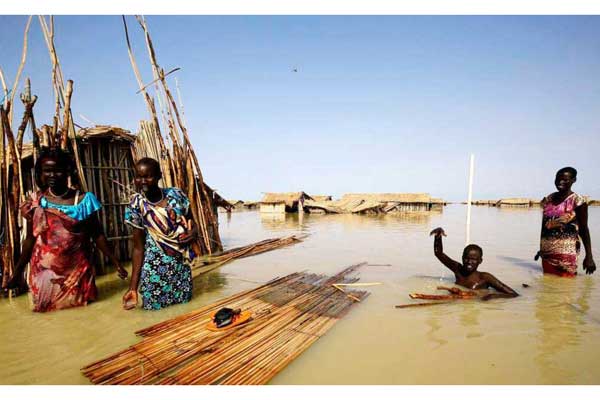Floods leave 20 dead in South Sudan

South Sudanese refugees try to repair their hut in flooded waters from the White Nile at a refugee camp that was inundated after heavy rain near in al-Qanaa in southern Sudan, on September 14, 2021. PHOTO | AFP
What you need to know:
- Last month, the United Nations Office of the Coordination of Humanitarian Affairs (UNOCHA) said at least 380,000 people from six states in South Sudan were displaced by flash floods and numerous waves of inter-communal clashes.
At least twenty people have died in South Sudan’s Warrap State as a result of continuous devastating floods, a senior State official has confirmed.
In a cell-phone interview with The EastAfrican on Friday, Victor Wek Gogrial West County Commissioner said those killed were mainly children and women.
“These deaths were recorded since the rains started in July. And the biggest cause of those deaths is drowning. As you all know Gogrial is swampy and it's always worsen by rains.
“As speak to you now, at least 17,500 people have been displaced, according to the assessment carried out by State Relief and Rehabilitation Commission” Wek narrated.
Wek added that nine payams under Gogrial West County have been affected.
“What is needed urgently now are sheltering materials to aid flood victims immediately, then food and non-food items would play a greater role in helping those that might starve and they are the majority” Wek stressed.
Last month, the United Nations Office of the Coordination of Humanitarian Affairs (UNOCHA) said at least 380,000 people from six states in South Sudan were displaced by flash floods and numerous waves of inter-communal clashes.
Last year, torrential rains and flash floods displaced thousands of people and destroyed several homes across South Sudan. The most affected areas were in Jonglei, Pibor, Upper Nile, Unity, Western, and Eastern Equatoria states.
According to the Intergovernmental Authority on Development (Igad) Climate Prediction, heavy rainfall is expected to continue in northern and central parts of South Sudan until mid of September.




